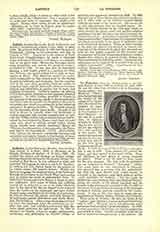

La Fontaine , JEAN DE, French poet, b. at Chateau-Thierry, July 8, 1621; d. at Paris, April 13, 1695. He was the eldest son of Charles de la Fontaine, a deputy-ranger, and Francoise Pidoux. After he had finished his studies at the college of his native town, he entered the Oratory (April 2, 1641) and was sent to the Seminary of Saint-Magloire. At the end of a novitiate of eighteen months, he realized that he was not fitted for the religious life and returned to the world. He studied law and was admitted to the bar, a fact now proved by the title given him in several official deeds. In 1647 he married Marie Hericart, who gave him a son in 1653. Their married life proved unhappy, and they agreed to live apart (1658). From his childhood he had shown a strong fondness for poetry. When a boy he used to write verses for his own pleasure. The first work he published was an imitation of Terence’s “Eunuchus” (1654). Two years later he was introduced to Fouquet, who granted him a pension with the understanding that the poet should send every month, as a receipt to the financier, some little piece of poetry—ode, madrigal, or rondeau. For six years he divided his time between Paris and Chateau-Thierry, giving six months to his official functions and six months to the pleasures of a courtier’s life. In 1664 he was sworn in as gentleman-in-waiting to the Dowager Duchess of Orleans, and was installed in the Luxembourg. It was at this time that he made the acquaintance of Moliere, Racine, Boileau, and Chapelle.
Three series of “Contes”, the first six books of his “Fables”, and”Psyche a novel, were published 4’rom 1665 to 1671. The poet was in full possession of his genius and had acquired a great reputation. In 1672, having squandered his fortune, he sold his rangership and settled in Paris. For the remainder of his life he had to depend on the generosity of his patrons. He first lived at Madame de la Sabliere’s, in the Rue Saint-Honore (1672-93), where he met a most brilliant society and became the intimate friend of men like Turenne, the Prince of Conti, Conde, La Rochefoucauld, and distinguished women like Mme de Se-vigne, Mme de La Fayette, Mme de Thianges. In 1674 he published a new series of “Contes”, which were seized by the lieutenant of police, and, in 1678, five books of “Fables”, that Mme de Sevigne pronounced “divine”. He was elected to the French Academy in 1683, but his election was suspended by Louis XIV, on account of the scandal of the “Contes”, and finally approved only in the following year, after the poet had publicly atoned for his licentious works in a “Ballade” published in the “Mercure” (January, 1684), and had promised “to be good”. When Mme de la Sabliere died, in January, 1693, he was sheltered by M. d’Hervart, maitre des requetes in the Parlement of Paris. A few months before, having been taken dangerously ill, he had begun to come back to the faith of his youth. In spite of his bad conduct, he had been indifferent rather than incredulous. The last two years of his life were most edifying. When he died those who put him into his shroud found that he was wearing a hair-cloth. He was buried in the cemetery of the Holy Innocents, in Paris. On account of his vivid and picturesque descriptions of the manners of animals, his wit, and his admirable naivete, as well as the concise and firm composition of his little poems, he will forever be regarded as the greatest of French fabulists.
LOUIS N. DELAMARRE

